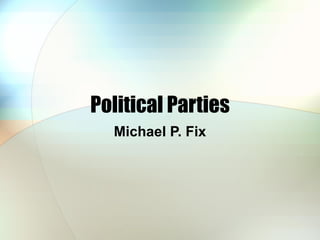Political Parties
- 1. Political Parties Michael P. Fix
- 2. What is a Political Party?
- 3. Political Parties Defined There is no single definition of political parties on which scholars can agree. Much of the debate on this has to do with party goals. In US, state governments largely control legal definition of parties
- 4. Political Parties Defined Pragmatic Party Model Parties are organizations that sponsor candidates for political office under the organization’s name in hopes of controlling the apparatus of government Responsible Party Model Parties are organizations that run candidates to shape the outcomes of government
- 5. Political Parties Defined VS. How do parties and interest groups differ? Images from www.wikipedia.org
- 6. Political Parties Defined How do parties and interest groups differ? Only Political Parties nominate and run candidates for office under their label. Political Parties focus on a platform – a broad range of issues over which they have a position. Political Parties are “quasi-public institution” and are accountable to state and local laws.
- 8. Party Functions Organizing the Election Process Facilitating Voter Choice Recruiting Candidates Screening Candidates Helping Candidates Organizing a Complex Government Aggregating Interests Educating Citizens Ensuring Accountability Social Functions Promoting Civic Performance
- 9. Party Roles
- 10. The Components of Political Parties Party-In-Government Party-in-the-Electorate Party Organization The Tripartite View of Parties
- 11. Party-in-Government All of the elected officials serving under a party’s banner
- 12. Party-in-the-Electorate Every citizen who attaches him or herself to a political party
- 13. Party Identification and Voting In some countries party membership is formal (e.g. Great Britain): Members must officially join Members must pay dues Members must attend local party meetings Members get to vote on party leaders and determine party platform
- 14. Party Identification and Voting In the U.S. party membership is a more ambiguous and fluid concept: No formal requirements to membership No formal requirement to change parties
- 15. Party Identification and Voting 2 Ways of Measuring Party ID in the U.S. Self-Identification Party enrollment
- 16. Party Identification and Voting
- 17. Party Identification and Voting Straight-Ticket Voters Voters who support candidates of the same party in every election. Split-Ticket Voters Voters who support candidates of different parties in the same election or from one election to the next.
- 19. Party-as-Organization The formal apparatus of the party, including party headquarters, offices, and leaders
- 20. Layers of the Party System
- 21. National Party Committees DNC Chair Tim Kaine RNC Chair Michael Steele
- 22. Party Machines Chicago Mayor Richard Daly, Jr. in front of an image of his father, one of the most powerful party boss in U.S. history.
- 23. Party Systems
- 24. Party Realignment A “partisan realignment” takes place when a large number of voters do not return to their party in the next election
- 25. Party Systems 1 st Party System (1790s-1824) 2 nd Party System (1824-1860) 3 rd Party System (1860-1896) 4 th Party System (1896-1932) 5 th Party System (1932-?)
- 26. Party Systems 1 st Party System (1790s-1824) Federalists (Gone by 1812) Democratic-Republicans
- 27. 1 st Party System The Whiskey Rebellion in 1784 was one of the key events that led to the development of the first two party system.
- 28. Party Systems 2 nd Party System (1824-1860) Whigs Democrats
- 29. 2 nd Party System Image from userwww.sfsu.edu Partisan Realignment over slavery and immigration led to the end of the 2 nd party system.
- 30. Party Systems 3 rd Party System (1860-1896) Democrats Republicans
- 31. 3 rd Party System Images from www2.ccs.k12.va.us
- 32. Party Systems 4 th Party System (1896-1932) Democrats Republicans
- 33. 4 th Party System Images from www.tqnyc.org
- 34. Party Systems 5 th Party System (1932-?) Democrats Republicans
- 35. What about 1968? Image from news.bbc.co.uk
- 36. Minor Parties
- 37. Third Parties in the U.S. System Ideological Parties Protest Parties Single-Issue Parties Splinter Parties
- 38. Ideological Parties Ideological Party Third party that exists to promote an ideology rather than to win elections In nearly every US presidential election this century the socialist parties have fielded a candidate. Image from www.sp-usa.org
- 39. Protest Parties Protest Parties Third party that arises in response to issues of popular concern which have not been addressed by the major parties William Jennings Bryan of the Populist Party did not win the presidency in 1896, but he came very close
- 40. Single-Issue Parties Single-Issue Party Third party formed around one particular cause Image from www.gp.org
- 41. Splinter Parties Splinter Party Third party formed by a dissatisfied faction of a major party Strom Thurmond (left) was a States’ Rights Democratic candidate for the presidency in 1948. The party formed in protest to the civil rights plan in the Democratic Party platform
- 42. Why Do Minor Parties Fail? Winner-Take-All Electoral System Legal Access to the Ballot
- 43. Why Do Minor Parties Fail? Cultural Consensus There is little support in the American political culture for avowedly fascist, communist, authoritarian, or other antidemocratic parties
